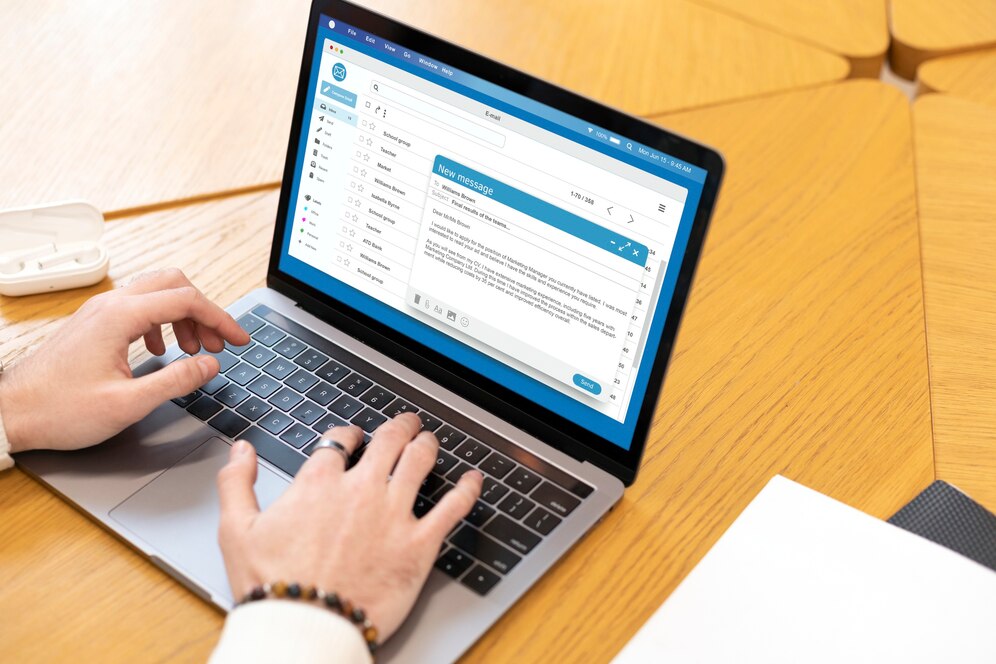Email Marketing Strategy for New eCommerce Websites
Starting a new eCommerce site feels a bit like throwing a party and crossing your fingers someone shows up. You’ve got the products, the website, maybe even a few ads running—but now what? How do you actually connect with potential buyers and keep them coming back?
That’s where email marketing comes in. It’s like your brand’s secret handshake—personal, powerful, and totally underrated if you ask me. So if you’re just getting your online store off the ground, here’s the email strategy I wish I had when I started.

Why Email Marketing Is a Game-Changer for New Online Stores
When you’re starting a new eCommerce store, it’s easy to get caught up in the hustle of building your site, sourcing products, and figuring out your pricing. But if you ignore one of the most powerful tools available to you—email marketing—you’re missing out on a huge opportunity.
So, why does email marketing matter so much for new online stores? Let me break it down.
1. You Own Your Audience
Social media is great for exposure, but let’s face it—you don’t own your followers. One algorithm change, and suddenly your organic reach drops like a rock. But with email, you own the list. Your customers gave you permission to pop into their inboxes, and that’s something you control. No matter what happens with social media trends, you have a direct line to your audience.
2. The ROI Is Insane
Did you know that for every $1 spent on email marketing, the average return is around $36? That’s some serious bang for your buck. When you’re just starting out and working with a tight budget, email marketing offers one of the highest returns compared to other marketing channels. No expensive ad spend required—just a little effort and consistency. The beauty of email marketing is that it works while you sleep, helping you build relationships and increase sales without having to constantly chase new customers.
3. You Can Build Strong, Personal Relationships
At its core, email marketing is about relationship-building. It’s one of the best ways to nurture trust with your audience. Think about it: people give you their email because they’re interested in what you offer, and that’s a privilege. With a well-crafted email series, you can introduce your brand, tell your story, and show your customers why they should care about what you’re selling. Over time, this builds loyalty, and loyal customers are far more likely to make repeat purchases. You’re not just trying to make one sale—you’re building a community.
4. Email Converts Like Crazy
I know what you’re thinking: “But what about social media?” Yes, platforms like Instagram or Facebook are great for brand awareness and engaging with your audience. But when it comes to conversions (turning someone from a visitor into a buyer), email leads the pack. Studies show that email marketing has a conversion rate that’s 6x higher than social media. It’s a more direct, personal approach that leads to action.
5. It’s Perfect for Automation
Automation is a game-changer for busy store owners. Once you’ve set up your email sequences (like a welcome series, abandoned cart reminders, and post-purchase follow-ups), they run on autopilot, doing the heavy lifting for you. You can engage your customers without lifting a finger, keeping them engaged, and nurturing them through their buying journey. Imagine waking up and seeing your sales tick up thanks to an email reminder you set up weeks ago—that’s the power of automation.
6. You Can Reach People at the Right Moment
Here’s a cool thing about email: you can target people at just the right time. Let’s say a customer abandons their cart while you’re fast asleep. Well, you can set up an automated abandoned cart email that gets sent to them within hours, reminding them what they left behind. With the right strategy, you can meet customers where they are and guide them back to your store at the exact moment they’re most likely to convert.
The Bottom Line
When you’re just starting an online store, you need to stretch every marketing dollar as far as it will go. Email marketing is an affordable, high-ROI tool that lets you nurture relationships with your customers, boost your conversions, and build a loyal following from day one. If you’re not already leveraging email marketing, now’s the time to dive in. Start small, stay consistent, and watch your list—and your sales—grow.
Email isn’t just a way to talk to your customers; it’s the foundation of a thriving online business. So, get your email strategy in place early, and let it work its magic as you build your eCommerce empire.

Choose the Right Email Marketing Platform
Alright, you’re ready to dive into email marketing, but before you start writing those killer email campaigns, there’s one thing you need to figure out: Which email marketing platform should you use?
Don’t stress—it’s not as complicated as it sounds. The right platform can make your life so much easier, especially when you’re juggling the million other things that come with running an eCommerce store. Here’s what you need to know to pick the best one for your business.
1. Look for Easy Integration with Your eCommerce Platform
The first thing you want to check is whether your email marketing platform can easily integrate with your store. Whether you’re on Shopify, WooCommerce, or Wix, you’ll want something that can sync customer data, orders, and behavior automatically.
Imagine this: Someone buys a product from your store. With the right platform, their email and purchase info will automatically be added to your list. This means you can send them follow-up emails, product recommendations, or even a thank you note—all without lifting a finger.
Some of the best email marketing platforms for eCommerce integration include:
-
Klaviyo – Super powerful for Shopify and BigCommerce users. It pulls in data from your store, making it easy to send personalized emails based on customer activity.
-
Omnisend – Great for integration across multiple platforms like Shopify, WooCommerce, and others. Plus, it offers cool features like SMS marketing alongside email, so you’re covered on all fronts.
-
Mailchimp – A classic choice, and it integrates with most eCommerce platforms, including WooCommerce and Shopify. It’s user-friendly for beginners, though it’s more basic than some of the others when it comes to automation.
2. User-Friendly Interface
I know you’re not trying to spend your precious time learning a complicated tool. You need something that’s easy to use from the get-go.
A drag-and-drop editor is a must-have for creating eye-catching emails without needing a degree in design. Look for platforms that allow you to easily set up automation flows and email templates, so you’re not starting from scratch every time.
-
MailerLite – Simple, intuitive, and perfect for beginners. It’s got drag-and-drop functionality, plus a ton of helpful pre-made templates to get you started.
-
Sendinblue – Another solid pick for beginners. It’s straightforward to use and offers a variety of customizable templates, along with automation features.
3. Automation and Segmentation Features
You’re running a busy eCommerce store, and time is precious, right? The magic of email marketing lies in automation and segmentation. You don’t want to be sending out individual emails to every customer manually—that’s not scalable.
With the right platform, you can automate follow-up emails, cart reminders, and welcome series, and personalize them based on customer behavior. This means that even if you have hundreds (or thousands) of subscribers, you can still give each one a personalized experience.
-
Klaviyo – It’s built for eCommerce and has amazing automation and segmentation capabilities. You can target specific customer behaviors, like browsing certain products or abandoning a cart, and send them highly relevant emails.
-
ActiveCampaign – Known for its advanced automation and segmentation features. You can create detailed workflows that nurture your customers through the buying process.
4. Pricing That Makes Sense
When you’re just starting out, your budget’s probably tight. But that doesn’t mean you need to compromise on quality. Most email platforms offer tiered pricing plans based on your list size and the features you need.
Here’s a rough idea of what you can expect from some popular platforms:
-
MailerLite – Offers a free plan for up to 1,000 subscribers, and their paid plans are super affordable, starting at just $10/month.
-
Omnisend – Has a generous free tier that lets you send up to 500 emails per month to 250 subscribers. Paid plans start at $16/month.
-
Klaviyo – It’s a bit pricier, but it’s worth it if you need powerful automation. You get 250 contacts for free, but it’s best suited for larger businesses once your list grows.
5. Customer Support and Resources
Even the best tools can leave you scratching your head now and then. Look for a platform that offers great customer support, whether that’s via chat, email, or phone. You’ll also want access to helpful resources like tutorials, guides, and community forums.
-
Omnisend – Offers great customer support via live chat, email, and an extensive knowledge base with tons of video tutorials.
-
Klaviyo – Known for top-notch customer service and resources, with a solid library of educational content and a community of eCommerce store owners to connect with.

6. Scalability
You don’t want to outgrow your platform too quickly. Make sure the email marketing tool you choose can grow with you. Look for platforms that allow you to easily upgrade as your list expands and your business needs evolve.
-
ActiveCampaign – Super scalable, so it’s a good choice if you’re planning to expand your email marketing efforts as your business grows.
-
Klaviyo – Scalable for high-volume stores. Whether you have a few hundred or several thousand customers, it can handle it all.
Final Thoughts: Picking the Right Platform for You
At the end of the day, the best email marketing platform for your new eCommerce store is the one that fits your needs, budget, and goals. Start simple—don’t worry about picking the “perfect” tool. Many of these platforms offer free trials, so you can test them out and see what works best for you.
Once you’ve picked your tool, you’ll be on your way to automating email flows, building your list, and, of course, boosting those sales. The right platform will help you work smarter, not harder.
So, which one are you thinking of trying? If you’re still unsure, dive into a free trial and see which platform feels most intuitive to you. And remember—getting started is the hardest part, but once you set up your first campaign, you’ll be cruising!
How to Start Growing Your Email List
You don’t need thousands of subscribers to start. You just need a reason for someone to sign up.
A few tried-and-true list-building ideas:
-
10% Off Their First Order – basic, but still effective
-
Free Shipping Coupon – adds real value
-
Exclusive Access to early drops or VIP sales
Place your signup forms in smart places:
-
A popup on exit intent or after a few seconds
-
A sticky bar at the top of your site
-
On your checkout page (checkbox opt-in)
Just don’t be annoying—no one likes a popup attack before they even see your homepage.
Set Up Essential Email Automations
Here’s the beauty of automation: you set it up once, and it works for you forever (well, almost). These are the ones you absolutely need from day one:
✅ Welcome Series
Think of this as your brand’s digital handshake. Introduce your story, show off your bestsellers, and make your new subscriber feel like part of something special.
✅ Abandoned Cart Emails
Someone added to cart but dipped before checkout? This is your chance to reel them back in. Remind them what they left behind and maybe sweeten the deal with a little discount.
✅ Post-Purchase Follow-Ups
Thank your customer, suggest related products, and ask for a review. It’s how you turn one-time buyers into loyal fans.
Send Engaging Campaigns That Keep People Interested
Aside from automations, you’ll want to send manual campaigns (aka newsletters) now and then. Don’t worry—you don’t have to be a copywriting wizard.
Here are a few content ideas:
-
New product launches
-
Behind-the-scenes peeks
-
Customer spotlights
-
Limited-time promotions
And please, don’t just sell in every email. Offer value, make people laugh, tell a story. Subject lines like “You left this in your cart 😢” or “We made a mistake (and you benefit)” work way better than “10% off everything now!”
Segment Your Audience for Better Results
Here’s where things get juicy. Not everyone on your list is the same. The more you can group them by behavior, the more relevant (and effective) your emails will be.
A few easy segments to start with:
-
New vs. returning customers
-
Cart abandoners
-
Buyers of a specific product category
That way, you’re not sending dog toy promos to someone who just bought a cat tree. Ya feel me?
Design & Copy Tips That Don’t Suck
You don’t need fancy design skills to make great emails. But a few basics go a long way:
-
Keep it mobile-friendly (most people read on their phones)
-
Use big buttons for your call-to-action (CTA)
-
Write like a human, not a robot
Instead of saying “View our latest collection,” try something like “Ready to meet your new favorite hoodie?”
Less stiff, more fun. That’s the goal.
Track, Tweak, Repeat
What gets measured gets improved, right? Keep an eye on:
-
Open rates (aim for 20–30%)
-
Click-through rates (above 2% is solid)
-
Unsubscribes (don’t stress unless it spikes)
Run A/B tests on subject lines, CTA buttons, or even send times. Just test one thing at a time so you know what’s actually making the difference.
Stay Legal, Stay Legit
It’s not the fun part, but it matters. Always:
-
Get permission before adding people to your list
-
Include an easy unsubscribe link
-
Honor privacy laws (like GDPR and CAN-SPAM)
Oh, and never ever buy email lists. That’s like trying to sell cookies to strangers in a dark alley. Creepy and illegal.

Final Thoughts (And a Gentle Push)
Starting with email doesn’t need to be overwhelming. Just focus on the basics:
-
Pick a tool
-
Start collecting emails
-
Set up a welcome flow
Even if you’ve only got five subscribers, treat them like VIPs. Your email list is your business’s heartbeat—and with a little care, it’ll grow into one of your strongest revenue drivers.
Go ahead, write that first welcome email. Your future self (and your bank account) will thank you.
(Maybe you are also interested: Marketing Automation Tools for eCommerce Startups)
FAQs
1. Why should I use email marketing for my new eCommerce store?
Email marketing is one of the most cost-effective ways to build direct relationships with your customers. For a new eCommerce website, it helps you engage with visitors, convert them into buyers, and keep them coming back. Unlike social media, where your content can get buried by algorithms, you own your email list. Plus, email marketing boasts one of the highest ROIs of any marketing channel—on average, you earn $36 for every $1 spent.
2. How do I grow my email list when starting from scratch?
Building an email list from the ground up can feel daunting, but there are plenty of ways to do it quickly and effectively:
-
Offer incentives like a discount on the first order or free shipping for new subscribers.
-
Add sign-up forms on your homepage, product pages, and during checkout.
-
Use pop-ups or exit-intent pop-ups to capture visitors before they leave.
-
Promote your list on social media and in your content—let people know they’ll get exclusive offers and updates if they sign up!
3. What are the must-have email automations for new eCommerce stores?
When you’re starting out, automation is your best friend. It saves you time while helping to nurture relationships with your customers. Here are a few must-have email automations:
-
Welcome series: Greet new subscribers and introduce your store’s story, mission, and top products.
-
Abandoned cart emails: Remind customers of the items they left behind and offer them an incentive to complete their purchase.
-
Post-purchase follow-ups: Thank your customers, ask for reviews, and suggest related products to keep them engaged.
These automations help you build rapport with your customers without having to manually send emails every time.
4. How often should I send emails to my subscribers?
It depends on your audience and your content, but a good starting point is once a week. You don’t want to overwhelm your subscribers, but you also don’t want them to forget about you. Here’s a simple schedule to try:
-
Welcome emails: Immediately after sign-up (and a few follow-up emails in the first week).
-
Abandoned cart emails: Within a few hours to a day after abandonment.
-
Newsletters/Promotions: Once a week, or a couple of times a month with product updates, promotions, or blog posts.
Make sure to monitor your open rates and unsubscribes to find the right balance.
5. How do I track the success of my email campaigns?
The key metrics to track include:
-
Open rates: This tells you how many people are opening your emails. Aim for 20-30% depending on your industry.
-
Click-through rates (CTR): This measures how many people clicked on the links in your email. A good CTR is typically above 2%.
-
Conversion rate: This is the percentage of people who clicked on your email and made a purchase. This is one of the most important metrics to monitor.
-
Unsubscribe rates: If this is high, it could mean your emails aren’t hitting the mark, and you might need to tweak your content or frequency.

